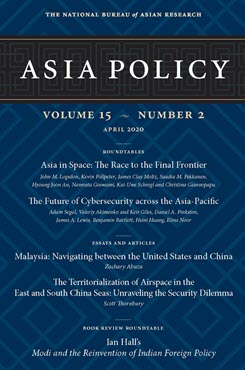Article from Asia Policy 15.2
The Territorialization of Airspace in the East and South China Seas
Unraveling the Security Dilemma
This article examines the perspectives and policies of both China and the U.S. regarding airspace claims in the East and South China Seas and offers a policy prescription to address the underlying political issues driving both nations toward a collision.
EXECUTIVE SUMMARY
MAIN ARGUMENT
The U.S. and China are moving further into a downward spiral based on misperceptions regarding each other’s airspace policies in the East and South China Seas. Weary of U.S. surveillance flights close to its borders, China has responded to such activities by increasingly challenging the right to conduct such flights. The desire to push U.S. military flights farther away has prompted China to establish an East China Sea air defense identification zone and erect similar restrictions, albeit on a smaller scale, in the South China Sea. The U.S., meanwhile, has interpreted these actions as incrementally destabilizing the rules-based international order as well as posing a direct threat to its long-held freedom of navigation interests. The Treaty on Open Skies provides a model to ease the political differences between the two countries by accounting for the core concerns driving U.S. and Chinese policies.
POLICY IMPLICATIONS
- Far from making the country more secure, China’s policy of contesting freedom of navigation outside its twelve nautical mile territorial sea demarcation invites the U.S. and other regional powers to oppose China through military operations to ensure access to the international commons around its mainland.
- Absent other measures that take Beijing’s perspective into account, continued U.S. freedom of navigation operations and surveillance flights in close proximity to China meant to keep air and sea space free and open will induce aggressive counterreactions that produce the opposite of the intended outcome.
- A bilateral framework based on the Treaty on Open Skies model that addresses the concerns of both states, while preserving their underlying interests, would add balance to the confrontational policies adopted by both states heretofore.
Scott Thornbury is a graduate student at the U.S. Naval War College (United States).
Note: The views presented in this article do not reflect the official positions of the U.S. Naval War College, Department of the Navy, or Department of Defense.
About Asia Policy
Asia Policy is a peer-reviewed scholarly journal presenting policy-relevant academic research on the Asia-Pacific that draws clear and concise conclusions useful to today’s policymakers. Asia Policy is published quarterly in January, April, July, and October and accepts submissions on a rolling basis. Learn more


